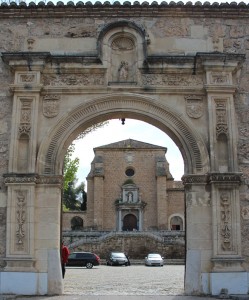 I spent Friday in the beautiful Spanish city of Granada. As I live quite near it, I’ve been many times but I had never visited La Cartuja (the Carthusian Monastery) or La Capilla Real (the Royal Chapel) so that was my mission.
I spent Friday in the beautiful Spanish city of Granada. As I live quite near it, I’ve been many times but I had never visited La Cartuja (the Carthusian Monastery) or La Capilla Real (the Royal Chapel) so that was my mission.
El Monasterio de Nuestra Señora de la Asunción, now known simply as La Cartuja de Granada, is a monastery of the Carthusian order which dates back to 1516. It is known for its beautiful Baroque church and sacristy, but I had come to see something else: the refectory with its series of paintings by Fray Juan Sánchez Cotán.
The refectory was a simple white-washed room with vaulted arches, stark in comparison to the rich marble and gold of the nearby church, but it held treasures for me. On its wall, were a number of painting by the famous Baroque painter and monk, Fray Juan Sánchez Cotán, telling the stories of Carthusian monks who had been persecuted for their faith. Included in the series, were paintings of the Carthusian monks killed by Henry VIII for refusing to recognise him as the Supreme Head of the Church. In the paintings, Sánchez Cotán depicts the monks being brought before Cromwell, some of the monks being imprisoned and chained in an upright position and others being hanged, drawn and quartered.
[slideshow id=533 w=400 h=400]
If you’re ever in Granada, the monastery is well worth a visit. Highlights include:
- The pretty cloisters with orange trees
- The breathtaking frescoed cupola and huge marble tabernacle of the sagragario (sanctuary)
- The beautiful sacristy with its unusual brown and white swirled Lanjarón marble, and cabinets and drawers inlaid with mahogany, ebony, lignum vitae, ivory, shell and silver.
- The gilt and mirrored altar which is said to have some of the bones of San Bruno (Bruno de Hartenfaust), founder of the Carthusian order, embedded in it.
- Works by Juan Sánchez Cotán, Pedro Atanasio Bocanegra, José de Mora and Antonio Palomino
Photography was not allowed in the monastery’s church but I found some photos on Flickr – click here to view them.
You can find out more about the persecution of the Carthusian monks in my article 19 June 1535 – 3 Carthusian Monks Hanged, Drawn and Quartered.
In my next post, I will be writing about my visit to the Capilla Real, stay tuned!
It sounds a beautiful place to visit, I hope you enjoyed every minute.
The painting are exquisitely done, he was very talented. He captured the desolation, suffering and the brutality inflicted on these poor men perfectly.
Did he ever paint any other pictures of less brutal times
Yes, he was known for his still life paintings – see http://en.wikipedia.org/wiki/Juan_S%C3%A1nchez_Cot%C3%A1n for an example.
One of his paintings in the refectory was a bit weird. It depicted a Carthusian monk praying while having an axe buried deep in his head!
Eeeewwww! something a bit surreal there. Artists do have some really strange, but very powerful concepts when expressing how they see things, and want us to see things. These are the paintings that you always seem to remember though, so their mission is accomplished.
That’s true and I expect the axe in the head while praying was to emphasise that not even intense suffering could separate these men from their faith.
Interesting..Thanks Tim. I also have just finished a book on the Grey sisters. It was very good and I recommend it. The title is The Sisters Who Would be Queen by Leandra De Lisle.
Thhis site ttruly has alll of the infomation I wanted about this
subject and didn’t know who to ask.
I’ve always found the Spanish monasteries, churches and Cathedrals to be full of artwork depicting torture, blood and gore! Granada Cathedral where Ferdinand and Isabel lie in tiny tombs, is a great example of painting of people being boiled in oil, flogged, etc etc. I felt relieved to leave. I’ve just returned from Italy where the Holy houses are so gentle in comparison in their depictions of history and Faith.
The Alhambra though is utterly enchanting.
The Alhambra is beautiful, as is the Alcazar in Seville. I really enjoyed seeing Ferdinand and Isabel’s tombs, with all the glass cases of documents, swords, jewellery etc. as well, and then the Carthusian monastery was incredible – so peaceful but then these rather brutal paintings in the refectory. Christianity’s history is full of brutality carried out in the name of God, so sad.